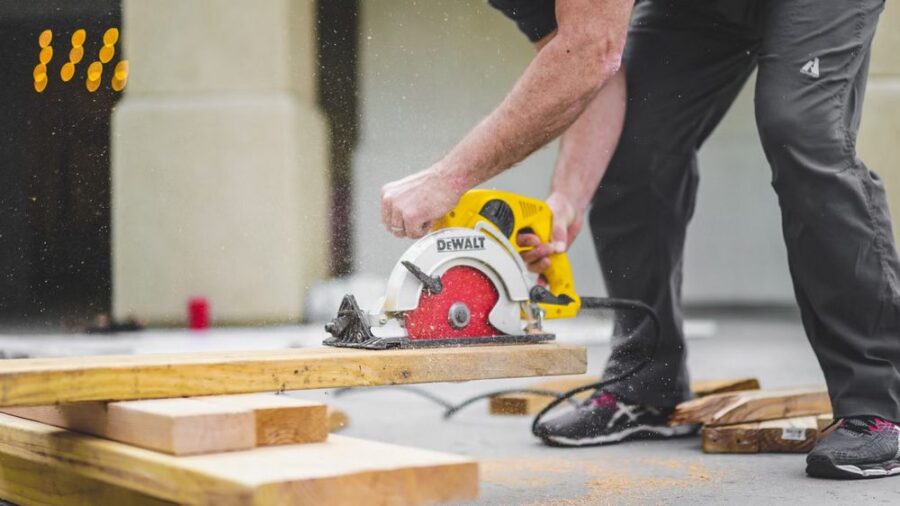Home improvement and construction projects are made much easier when you have the right tools for the job. But with so many different power tools available, how do you know which ones are ideal for your needs?
The Right Tools for the Job

To complete any household or construction job quickly and with less effort, shop for the latest and greatest power tools from reliable tool shops. Here you will find tools for every budget and skill level, suitable for different home or work circumstances, such as whether you’re working in one place or need the tool to be portable. Here are the most popular types used for various tasks and materials.
Drills
A drill is used to bore holes in materials and can perform various light jobs, including mounting mirrors and cupboards and installing shelving and TV brackets. Depending on the drill you use, it can drill through wood, plasterboard, brick, masonry, and even metal.
Each drill is designed for specific tasks and materials. A drill driver combines a drill and a screwdriver. A hammer (SDS) or percussion drill is required to drill holes in strong masonry materials. There is also the combi drill, which combines a drill driver and a hammer drill into one, making it a great all-purpose tool.
When purchasing a drill, consider the drilling jobs you’ll need it for and the material you’ll be drilling into. This can assist you in determining the type of drill you require. Then think about how frequently you will use the drill, how portable you need it to be, and whether you need a corded or cordless one.
Screwdrivers
An electric screwdriver inserts screws into wood or pre-drilled holes in other materials. It’s ideal for assembling flat-pack furniture and other screw-based items. Tool shops offer three different types of electric screwdrivers. A straight screwdriver has a straight handle and resembles a manual one. The second type is a pistol screwdriver, which has the shape of a drill. Finally, there is the electric screwdriver that will hold and feed screws while you work.
When hitting the tool store, consider your needs. Will you be utilising it for DIY or professional purposes? Straight electric screwdrivers are ideal for DIYers who need to perform light screw-driving operations. Pistol screwdrivers vary in power. Low-powered variants are ideal for screwing into soft materials, while higher-powered models are excellent for screwing into harder materials. The screwdriver that feeds screws while you work is intended for professional use only.
Nail Guns
A nail gun is used to drive nails into strong materials in a single rapid, smooth operation, significantly decreasing the time and effort required to execute the same work manually using a hammer. It’s ideal for large-scale or repetitive nailing jobs like laying decking or flooring, roofing, fencing, and furniture manufacturing.
All nail guns can be classified into two types: first fix and second fix. First-fix nail guns are designed to accomplish rough woodwork and building works where the nails will be hidden. Second-fix nail guns are made for more sophisticated ‘finishing off’ operations where the nails are visible, such as furniture assembly, skirting board securing, and door frame installation.
The most important factor to consider when buying is the task you intend to use it for. This will decide the type and size of nails to drive, as well as the type of nail gun required. Consider whether it has to be portable and whether it will be used infrequently or frequently by professionals. This will assist you in determining if you want a corded or cordless model, as well as the power type.
Sanders
A sander is used to provide a smooth, professional finish on various materials. They are useful for sanding wood and removing varnish, paint, and rust from wood and metal. There are several types available. An orbital sander is a sander with a rotary base plate. It’s great for fast-removing varnish and paint.
A drywall sander is an orbital sander built primarily for sanding down drywall. A sheet sander, like a belt sander, is used to quickly sand down wood. A detail sander has a small triangle head that can reach corners and tight spaces, making it ideal for precise work. A disc sander is a tabletop sander used to remove vast volumes of wood.
One of the most important things to consider is what type of base plate you will need. Choose a revolving base plate for removing paint and varnish, a vibrating or belt base plate for swiftly sanding wood, and a triangular-shaped base plate for accessing nooks and crannies.
Also, consider the base plate size and speed. A large and rapid base plate will complete the task faster than a smaller, slower one, but with less accuracy. Additionally, take into account whether it needs to be portable for rare DIY or frequent professional use. This can help you determine whether you will need electric or cordless sanders, as well as the power type.



